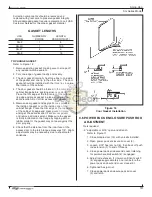
17
revised 09/09
Smog-Hog
SG Series Model
• Broken ionizer wires.
• Contaminant build up and or cracked ionizer stand
off insulators and or high voltage door feed through
insulators.
• Carbon tracking (black streak) to the ionizer stand
off insulators and or high voltage door feed through
insulator (replace insulator)
• Ionizer wires not “taut” contacting the ground
plates.
• Bent ionizer wire support bar contacting a
“grounded surface.”
• Bent ground plates contacting the ionizer wires.
• Surface oxidation to unicell component requiring
a replacement.
• Unicell is structurally weak, loose steel rivets,
deterioration to cell place spacers or paper thin cell
plates due to utilizing the improper detergent.
Parts should be replaced as required.
Sometimes a flashing indicator light will clear itself
by removing the unicell(s) from the module and then
installing the unicell(s) back into the unit.
the Bench test Procedure will determine which
unicell(s) are causing a blinking indicator light.
refer to Section 10.3.
Place toggle switch in the off position; connect all wires
which have been disconnected and install unicell(s).
10.2 HIGH VOLTAGE PROBE
MEASUREMENTS
a high voltage probe (refer to manufacturers
instructions) is required to measure high voltage output
from the power pack. the component door should
be closed with unicell(s) installed, the indicator light
illuminated and high voltage wires #8 and #7 connected
to the power pack. refer to figure 19. if the indicator
light is flashing or not illuminated perform step 1 and if
required step 2.
“With Load” is a measurement with high voltage
wires #8 and #7 connected to the power pack and
unicell(s) installed.
1. Place toggle switch to the power pack enclosure
in the on position.
2. open the lid door to the power pack enclosure
and connect the ground wire from the high voltage
probe to the bare metal push rod. refer to
figure 11.
3. engage the interlock switch and place the tip
of the high voltage probe to the ionizer door
feed through insulator bolt. the high voltage
measurement should be 10.0 to 11.8 KVDc.
if the ionizer voltage is below specifications refer
step 2, “ionizer conditions causing failure.”
Bench Testing may also be required. Low ionizer
voltage will decrease the collector cell voltage but
low cell voltage will not affect the ionizer voltage.
4. engage the interlock switch and place the tip of
the high voltage probe to the collector cell door
feed through insulator bolt. the high voltage
measurement should be 5.0 to 7.3 KVDc. if the
collector cell voltage is below specifications refer
step 2, “collector cell conditions causing failure.”
Bench Testing may also be required.
“No Load” is a measurement of the power pack with
high voltage wires #8 and #7 disconnected from the
power pack.
1. Place toggle switch to the power pack enclosure in
the off position.
2. remove the high voltage wires #8 and #7 from
the power pack gently bend high voltage wires to
eliminate the high voltage wires from touching the
power pack connectors.
3. Place toggle switch to the power pack enclosure in
the on position.
4. engage the interlock switch and place the tip of
the high voltage probe to the ionizer and to the
collector power pack connectors. the high voltage
measurement should be 10.0 to 11.8 KVDc to the
ionizer and 5.0 to 7.3 KVDc to the collector cell. if
high voltage is below specifications to one or both
circuits replace the power pack.
10.3 BENCH TEST PROCEDURE
This procedure can be utilized to determine an
electrical problem with the unicell(s) or a power
pack or testing the unicell(s) after manual cleaning.
Do not use a power pack that is not within the high
voltage specifications, refer to “Testing The Power
Pack”.
PROCEDURE
teStinG tHe ioniZer
1. Select one unicell to be tested.
2. connect one high voltage wire to the ionizer
contact spring and to the power pack connector
identified as “ionizer #8”.
3. connect the other high voltage wire (use as a
ground wire) to the metal frame of the unicell and
to the ground stud on the power pack.
4. ac cable should be connected to the power pack
connectors 5 and 6 with ground wire secured to
the ground stud on the power pack.
5. connect ac cable plug to the wall outlet.
6. Measure high voltage with the high voltage probe
at the ionizer contact spring. ionizer voltage
should be 10.0 to 11.8 KVDC, not to exceed 12.0
KVDC. If ionizer voltage exceeds 12.0 KVDC, the
ionizer wires are moderately to extremely coated
with contaminant (clean ionizer wires), or the
power pack is not within specifications.










































